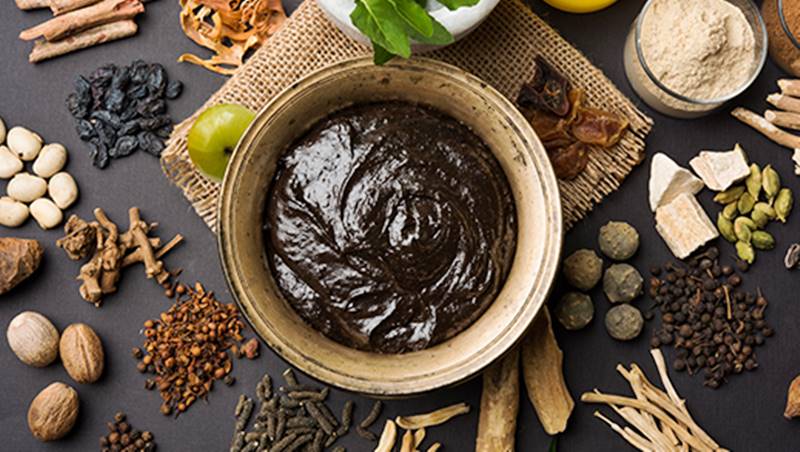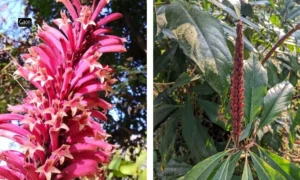Coimbatore, Tamil Nadu
Along with the Diwali goodies, my daughter-in-law came bearing a shiny steel container filled to the brim with a glistening, garnet-coloured, concoction that immediately set off a wave of nostalgia.
In Tamil Nadu it is called Deepavali lehyam or marundhu (medicine), and the women in Tamil households invariably make it or at least used to make it along with the laddus, murukkus, mixture and mysore pak. My daughter-in-law’s grandmother, 70-year-old Lalitha Arunachalam, made it at home in Bengaluru and sent it along with so much love for me and my husband.
It sent me right back to the Deepavali of yore when we awoke in a fever of excitement at three in the morning, had an oil-bath, and wore the brand new clothes laid out neatly at the family altar the night before.
Each piece of new clothing had a tiny smear of manjal (turmeric) applied discreetly out of sight, on the border, on the inside of the collar where it would not be seen; this was a must as the turmeric was said to ward off the evil eye also known as infections.
A piping hot bath, new clothes and an unbearable wait later, we would be handed a sparkler each, that would be lit from the lamp at the altar by a responsible adult which we then waved around after being safely escorted out of the kitchen, away from inflammables. The grown ups would have the honour of firing the first loud cracker of the day, perhaps to wake up our gods.
Then came the Deepavali lehyam. Kids would line up and a spoonful of the lehyam would be scooped out of the steel dabba (container) it was stored in, shaped into small marble-sized balls, and plopped into the little outstretched palms. We would swallow it or bite into it depending on how fond we were of the lehyam and then rush off to greet our friends and cousins and extract every bit of fun we could from that oh-so-special day (lehyam recipe at the end of this article).
Prevention is better than cure
The wonderful thing about the Deepavali lehyam was that it was eaten first thing in the morning. Everyone knows they will overeat sweets, snacks and delicacies on Diwali. So the lehyam was the valiant soldier that kept guard in our tummies, daring any infection to enter. The ingredients in it were all natural and healing.
These ingredients were guaranteed to withstand the onslaught of sweets, mounds of murukkus and mixture we would stuff our faces with. Also, thinking back, I feel the ingredients in the lehyam also acted as a protection against the creeping chill in the air as Diwali usually heralds the winter months.
How wonderfully wise our elders were! They knew better than to try and prevent overeating, that would be so unfair more so since the smells of the frying goodies pervaded our homes a full week or even a fortnight before. Everyone would have exercised utmost restraint until the morning of Deepavali after which there were no rules!
So, rather than asking us to eat less, which would have been a silly thing to do, the wise women in the family would strike a bargain – “Eat the lehyam, and you can eat all you want the rest of the day,” they would declare. How could one resist that offer!
Deepavali lehyam – prevention and cure
Not that the lehyam was an unpleasant thing to eat. It looks like chyawanprash and has a distinctive tang, pungency and sweet all at the same time.
Some of the ingredients I remember that went into it were coriander seeds, black pepper, ginger, cloves, carom seeds (omam in Tamil and ajwain in Hindi), cumin seeds, jaggery, arisi and kandha thippili the bark and the dried fruit of the piper longum plant, chitharathai or lesser galangal, and of course, the omnipresent ghee and then some honey.
I have a vivid recollection of the tiny twig-like thippili sitting pretty amongst a host of others in a small shop in the Coonoor market, years ago, that smelt divine with unfamiliar fragrances. I don’t know how many of those ingredients are lost to us forever. They were once an indispensable presence on the kitchen shelves at home to prevent colds, indigestion, fevers, soothe various kinds of pains, nourish the pregnant and the lactating mothers, strengthen bones, enrich the blood, and so on.
So many of our traditional everyday foods were medicinal. I actually have no real recollection of a medicine cabinet or a medicine box growing up.
Coming back to the lehyam, I requested Lalita Mami to share her recipe which she did generously. Not just that, she also patiently explained how each ingredient in it had a role to play. The turmeric was a healing agent, she pointed out.
The chitharathai and the thippilis played the role of cold and cough slayers, the pepper and ginger as we all know took care of that pesky cough, the gale mein khich khich (throat irritation), and the athimathuram (liquorice) took care of wheezing from inhaling all that smoke from fireworks. In its entirety, the lehyam fortified our digestion.
Lalita Mami told me that nowadays ready made powders were available that one just had to mix together to make the lehyam, but to my mind that would lose so much of the enchantment associated with Diwali.
Maybe next year, I shall try and make it myself. I feel I have a responsibility to keep the good and meaningful traditions alive, traditions that stem from sound sense. Like the Deepavali lehyam, that is drawn from natural foods, is sustainable, seasonal and local, tastes delicious and fortifies our planet along with our digestion.
Lalitha Mami’s recipe
Mami said she rarely measured ingredients and used her eyes and hands to tell her the right amount, but she kindly worked out the approximate measurements for me. She also added that the recipes differed almost home to home. People added raisins, dates and so on, and that was the cook’s prerogative to improvise as she or he went along.
Ingredients
Ginger 100 grams: To be peeled and soaked for at least an hour.
Separately, soak overnight and grind together:
Coriander: 2 tsps
Black whole pepper: 2 tsps
Cumin/Jeera: 2 tsps
Ajwain: 2 tsps
Cloves: 4
Cardamom:2
Make a syrup with:
Jaggery: 250 gms
Water: Just enough to dissolve the jaggery and bring it to a boil
To be added later
Athimathuram powder: 2 tsps
Chitharathai power: 2 tsps
Dried ginger powder: 1 tsps
Turmeric powder: 1 tsp
Final touches
Gingelly oil: 2 tsps
Ghee: 2 tsps
Honey: 2 tsps
Procedure
- Grind the ginger into a smooth, buttery paste.
- Grind the coriander, pepper, cumin, ajwain,cloves, cardamom along with half a glass of water till smooth
- Prepare a syrup with the jaggery and enough water to help it dissolve.
Put the smooth and buttery ginger paste into a hot pan. Add the coriander, pepper cumin….paste to it too. Cook for a while stirring continuously. It will thicken at which point add the powders to it and cook till the mixture thickens further and becomes viscous. Turn off the heat and add the ghee, gingelly oil and honey to it, give it a brisk mix and allow to cool before storing it. The lehyam lasts for a long time.

















